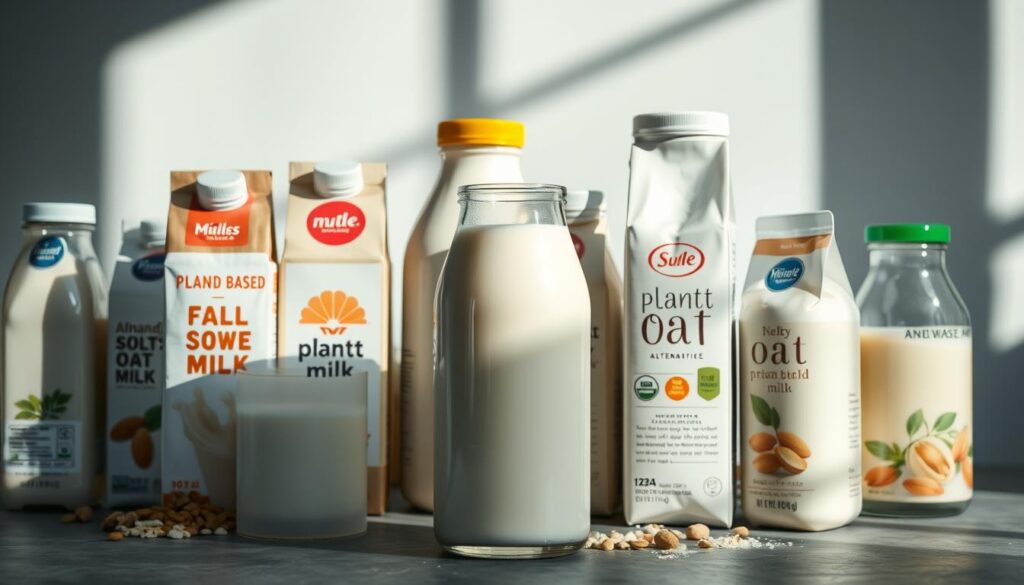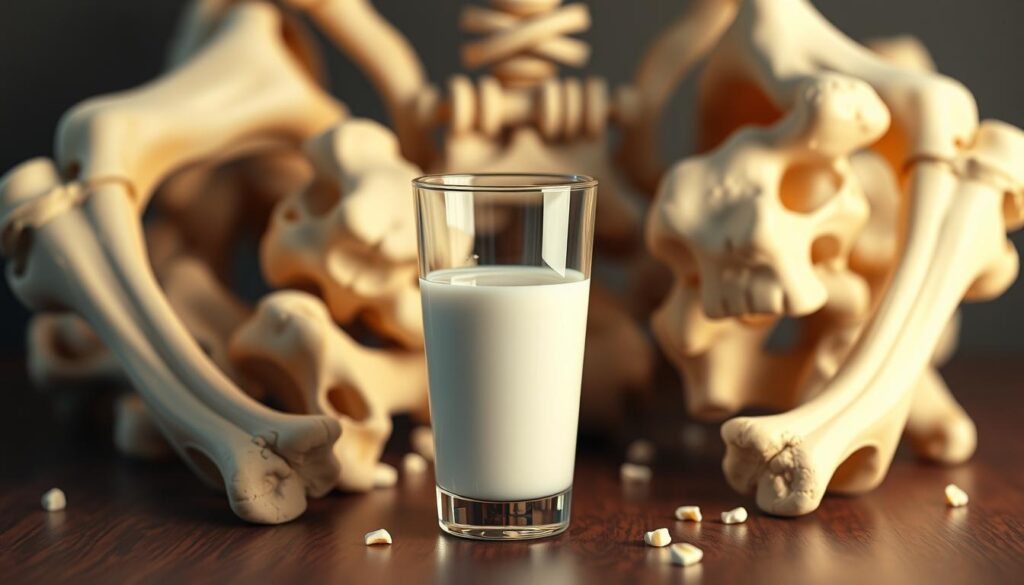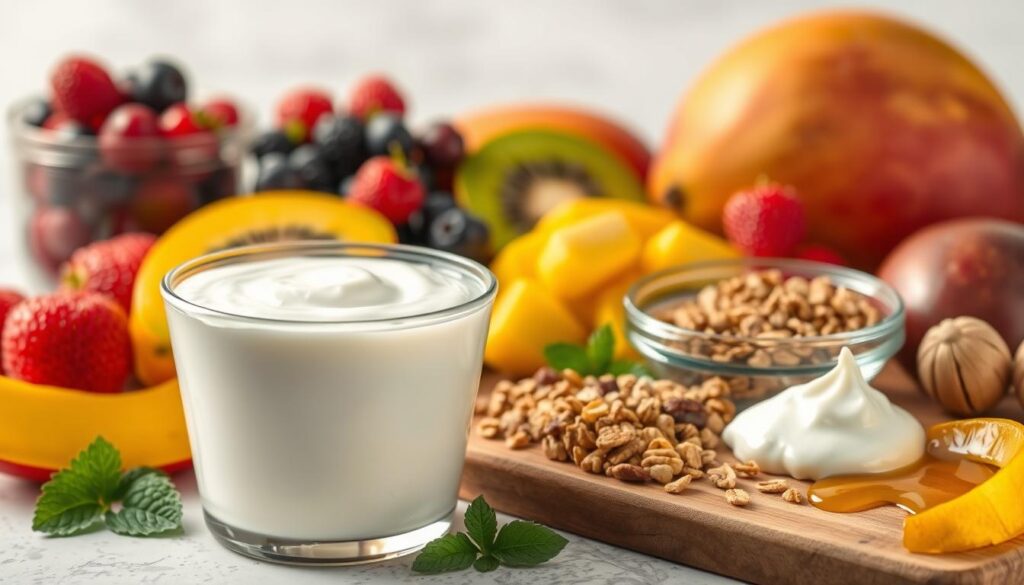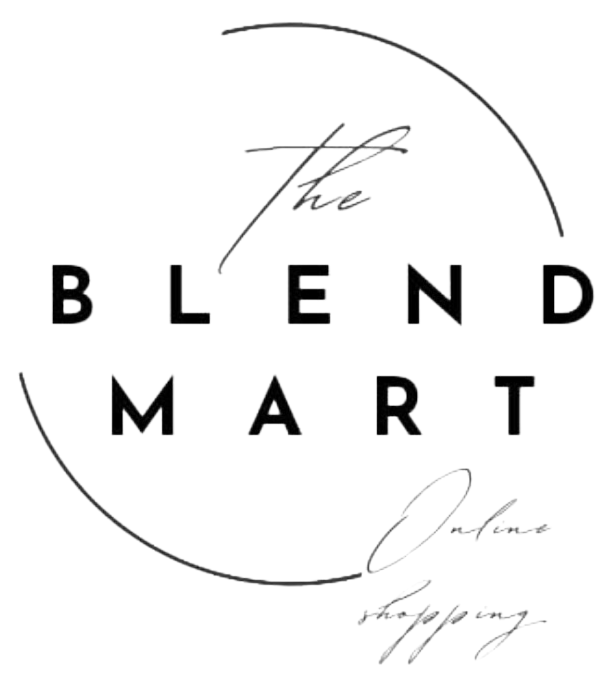Have you ever wondered if milk is really good for you, or just a throwback to childhood? This article will show you the many benefits of milk. It will also explore the nutritional value of dairy products that people have loved for ages.
This guide will help you understand the different types of milk and how they affect your health. You’ll discover the important nutrients in milk, its role in keeping bones strong, and more. By the end, you’ll know how to choose milk wisely for your daily needs.
Key Takeaways
- Milk has been a staple for humans for about 10,000 years, giving us vital nutrients.
- Whole cow’s milk has 8 grams of protein and 28% of the daily calcium RDA per cup.
- Dairy products can help with bone health and managing weight.
- Lactose intolerance is common and something to keep in mind.
- The dietary guidelines recommend three servings of milk a day to boost calcium intake.
Introduction to Milk and Its History
Milk has been around for thousands of years. It started with female mammals making it for their babies. Over time, different cultures have found their own ways to use milk.
Early people started making cheese and yogurt from milk. They did this by fermenting it. This was about 6,000 to 8,000 years ago. It was a big change in how people got their food.
Milk has always been useful. In America, it became important during hard times in the late 1700s. By the late 1800s, people knew it was good for them, like helping fight off smallpox.
Today, milk is a big part of many diets. Over six billion people drink it or use its products. The mix of old ways and new ideas has made milk a key part of many cultures.
The Nutritional Profile of Milk
Milk is a nutritional powerhouse, packed with vitamins and minerals essential for health. It has calcium, vitamin D, protein, and vitamin B12. These nutrients are key to meeting daily nutritional needs.
One cup of whole cow’s milk gives you about 28% of the daily calcium you need. It also has riboflavin, potassium, and healthy fats. These support a balanced diet.
Key Nutrients in Milk
The nutrient composition of milk is rich and varied. This makes it a vital part of our diet. Here’s how milk contributes to your daily nutrient intake:
| Nutrient | Percent Contribution from Dairy Sources |
|---|---|
| Calcium | 54.7% |
| Riboflavin | 28.1% |
| Vitamin B12 | 26.1% |
| Phosphorus | 24.6% |
| Protein | 10-20% |
| Saturated Fatty Acids | 10-20% |
| Zinc | 13.87% |
| Magnesium | 10.98% |
| Vitamin A | 10-20% |
Comparative Analysis of Milk Types
Knowing the differences between milk types helps you make better choices. Cow’s milk is the most produced and a major nutrient source. Plant-based milks like almond and soy have different profiles.
Cow’s milk is high in protein and calcium, but plant-based milks may have added sugars. It’s important to consider fat content and nutritional value when choosing milk. This ensures it meets your health goals.
Milk: A Benefit and Flavorful Choice for Your Diet

Milk is a key player in a healthy diet, packed with essential nutrients. It not only nourishes but also boosts your overall health. Knowing the health benefits of milk helps you make better choices for your well-being.
Essential Nutrients Found in Milk
Milk is a treasure trove of nutrients for good health. A single serving offers:
| Nutrient | Whole Milk (1 cup) | Nonfat Milk (1 cup) |
|---|---|---|
| Calories | 149 | 83 |
| Fat (grams) | 7.9 | 0.2 |
| Protein (grams) | 7.7 | 8.2 |
| Calcium (milligrams) | 276 | 298 |
| Vitamin D (micrograms) | 3.2 | 2.9 |
Milk is rich in calcium and vitamin D, which are great for bones and muscles. Its protein helps keep muscle mass, which is good for those who are active.
Health Benefits of Regular Milk Consumption
Drinking milk daily can bring many health benefits. It’s good for bone density, which is important for kids and older adults. It also helps prevent osteoporosis later in life.
Milk is not just for bones; it’s also full of potassium and vitamins. More potassium means a lower risk of stroke and better heart health.
Drinking milk can also help your muscles recover after working out. Its protein is key for muscle repair, which is great for athletes or anyone who exercises a lot. Adding milk to your diet can greatly improve your nutrition and health.
Different Types of Milk

Today, we have many milk options to choose from. Cow’s milk is a classic, but plant-based alternatives like almond, soy, and oat milk are becoming more popular. Each milk type has its own nutritional benefits, meeting different health needs and tastes.
Cow’s Milk Versus Plant-Based Alternatives
Cow’s milk is packed with protein and nutrients like calcium and vitamins A and D. A single serving of whole cow’s milk gives you:
| Component | Whole Cow’s Milk | Almond Milk | Soy Milk | Oat Milk |
|---|---|---|---|---|
| Calories | 156 | 41 | 38 | 120 |
| Protein (g) | 8 | 1 | 3.5 | 3 |
| Calcium (DV) | 29% | 50% | 10% | 25% |
| Fat (g) | 9 | 3 | 2 | 5 |
Almond milk is loved for its low calories and heart-healthy fats. But it has less protein than cow’s milk. Soy milk, on the other hand, has as much protein as dairy milk. It’s great for those with lactose intolerance. Soy milk also has fat, but it’s full of nutrients and often has extra calcium and vitamin D.
Understanding Whole, Skim, and Semi-Skimmed Milk
Within cow’s milk, you can find whole, skim, and semi-skimmed types. Whole milk has more fat, giving it a richer taste and helping you feel full longer. Skim milk keeps all the important nutrients but has less saturated fat, making it good for your heart. Semi-skimmed milk offers a creamy feel with less fat.
As more people look for dairy-free options, knowing the differences between milk types can improve your diet. Whether you pick cow’s milk or plant-based alternatives, each has benefits to consider.
The Role of Milk in Bone Health

Milk is key for strong bones because it’s packed with calcium and vitamin D. These nutrients help keep bones strong all our lives. Drinking milk regularly can boost bone mass and lower the risk of osteoporosis.
Calcium and Vitamin D Contributions
Milk is a top source of calcium, with about 300 mg per cup. Most of our body’s calcium is in our bones. Vitamin D in milk helps our body use calcium better, making bones stronger. Eating foods rich in calcium and vitamin D is great for bone health.
Studies Linking Milk Consumption to Bone Density
Studies show milk helps bones stay dense. Drinking less milk in teens can lead to weaker bones later. Girls who drank less milk as kids had 5.6% less bone mineral than those who drank more.
Research also shows dairy products, like milk, are good for kids’ bones. A big study on female nurses found milk didn’t affect fracture rates. Another study with men found milk helps in a balanced diet for bones.
This research highlights the value of milk for bone health. It’s important to include milk in your diet for strong bones.
Protein and Its Importance in Milk

Milk is a key source of protein. It has about 3.5% protein by weight, which is 36 grams per liter. This protein is important for our bodies, helping with muscle growth and repair.
The Quality of Protein in Milk
Milk is known for its high-quality protein. It has all nine essential amino acids we need. The two main proteins in milk are casein and whey. Casein makes up 80%, and whey makes up 20%.
Each type of protein has its own benefits. They help with different health and fitness goals.
| Type of Protein | Percentage in Milk | Key Benefits |
|---|---|---|
| Casein | 80% | Slow digestion; beneficial for muscle preservation and improved sleep quality when consumed before bed |
| Whey | 20% | Rapid absorption; promotes muscle recovery and may help suppress appetite more effectively than other protein sources |
Protein’s Role in Muscle Growth and Repair
Adding milk to your diet can help with muscle recovery after working out. Whey protein in milk is better for muscle repair than other proteins. Drinking protein-rich milk can prevent muscle loss and help build strength.
Potential Health Risks and Considerations

When exploring dairy options, it’s key to know about health risks. This includes lactose intolerance and dairy sensitivities. Many people face discomfort from lactose in dairy products. Others might have milk allergies, leading to digestive and skin issues.
Lactose Intolerance and Dairy Sensitivities
About 65 to 70% of the world’s population has lactose intolerance. Symptoms include bloating, gas, and diarrhea after dairy. This is due to low lactase levels, an enzyme needed to digest lactose.
Those with dairy sensitivities or milk allergies can have mild to severe reactions. It’s important to check food labels to avoid triggers. Luckily, lactose-free alternatives are available, keeping the taste and nutrients of regular dairy.
Many brands offer lactose-free milk. It has the same nutrients as regular milk, like calcium and protein. This makes it easier to enjoy dairy without discomfort.
Debunking Myths about Milk and Health
There are many myths about milk and health. Some say dairy causes chronic health issues, but science often disagrees. For example, milk can help you feel full, leading to less fat intake.
Studies also show no big difference in allergic reactions between raw and pasteurized milk. This clears up common misconceptions.
Here’s a quick look at some common myths about milk and the facts:
| Myth | Truth |
|---|---|
| All dairy products cause weight gain. | Milk may help in managing weight by improving feelings of fullness. |
| Milk consumption is directly linked to acne. | Studies show mixed results; low-fat milk has been associated with higher acne prevalence but not all individuals react the same way. |
| Dairy is harmful to bone health. | Research indicates milk provides essential nutrients like calcium and vitamin D, which are key for bone health. |
| Raw milk is always healthier than pasteurized milk. | Raw milk can have harmful pathogens, and pasteurization doesn’t affect calcium bioavailability much. |
Understanding milk and dairy is important. It helps manage sensitivities and allergies. It also lets you make choices that fit your health needs.
Dairy Products: Beyond Milk

Dairy products are more than just milk. They offer many health benefits. Adding yogurt and cheese to your diet can greatly improve your health. Yogurt is good for your gut health, thanks to its probiotics. Cheese is a great source of calcium and protein.
These foods are full of nutrients. They help your body in many ways. You can easily add them to your meals every day.
Yogurt and Cheese Nutritional Benefits
Yogurt and cheese are full of good stuff. A cup of low-fat yogurt has 154 calories, 13 grams of protein, and 450 mg of calcium. This is great for your bones.
Cheddar cheese has about 113 calories, 7 grams of protein, and 200 mg of calcium per slice. Both yogurt and cheese help keep your immune system strong. They have vitamin B12, which is important for your nerves and DNA.
Creative Ways to Incorporate Dairy in Your Meals
There are many ways to add dairy to your meals. Try adding yogurt to smoothies for a creamy texture and probiotics. It’s also good in overnight oats or sauces.
Use cheese to make salads, sandwiches, or pizzas better. It adds flavor and richness. Adding yogurt and cheese to your meals can make them taste better and be healthier.
The Impact of Milk on Weight Management

Many people struggle with weight management, with over 42% of Americans being obese. You might be curious about milk’s role in managing weight. Whole milk is known for its ability to make you feel full, which is key for losing weight. Studies show that adding milk to your diet can help you eat fewer calories.
How Milk Affects Satiety and Weight Loss
Research shows that drinking whole milk can help with weight management. Each cup of whole milk is linked to a 0.5 kg/m² lower BMI. This means milk can help you feel full and may lead to a lower body weight.
People who drink milk daily also see a drop in waist size. On average, they lose 1.1 cm for each cup they drink. This is a clear sign that milk can aid in weight loss.
Research Studies on Dairy and Obesity
Studies have found a strong link between dairy and lower obesity rates. Drinking whole milk daily can lead to a 3.2% drop in obesity rates per cup. Including dairy in your diet can offer significant weight management benefits.
Children who drink milk regularly are less likely to be obese. One study found a 59% lower risk of obesity in kids who consume a lot of dairy. This shows that milk is a vital part of a healthy diet for kids.
The connection between milk and weight loss is clear. Adding dairy to your diet can be a simple way to stay healthy. As obesity rates in young people rise, promoting milk consumption is a smart move. It’s clear that milk plays a big role in managing weight, making it a key part of a healthy lifestyle.
The Truth About Milk and Dairy Products
Misunderstandings about dairy can affect what we eat. Knowing the truth about milk helps us make better choices. This part aims to clear up common myths and show how different dairy products vary in nutrition.
Common Misconceptions About Dairy
Many believe all dairy is the same in health benefits. Some think whole milk is bad for you. But, studies show full-fat dairy might actually help with weight and heart health.
By debunking these myths, we can see the real health perks of dairy. These benefits are often missed.
Nutritional Variabilities Among Dairy Products
Dairy products have different nutritional values. Milk, for example, is packed with thirteen essential nutrients. It meets about 22% of our daily calcium, 40% of vitamin D, and 10% of potassium needs.
Flavored milk also adds valuable nutrients, like 2% of calcium and 5% of vitamin D. It’s important to remember that not all dairy is the same. How it’s processed and its fat content can affect its health benefits.
| Dairy Product | Calories per 200ml | Calcium (% Daily Value) | Vitamin D (% Daily Value) | Protein (grams) |
|---|---|---|---|---|
| Whole Milk | 150 | 33% | 20% | 6.5 |
| Semi-Skimmed Milk | 100 | 33% | 20% | 6.5 |
| Fat-Free Milk | 80 | 33% | 20% | 6.5 |
| Flavored Milk | 130 | 2% | 5% | 5.5 |
Integrating Milk into Balanced Diets

Adding milk to your diet can boost your health by giving you important nutrients. The Dietary Guidelines for Americans suggest eating three servings of dairy a day. This helps keep your body full of calcium and other nutrients that are good for you. Knowing how much milk to drink is key to following these guidelines.
Daily Recommendations for Dairy Intake
It’s very important to get enough dairy every day. Both adults and kids need to make sure they’re getting enough calcium, vitamin D, and protein. Soft cheeses, yogurt, and milk each have their own benefits for a balanced diet. Here’s what you should aim for each day:
| Age Group | Recommended Daily Servings |
|---|---|
| Children (2-3 years) | 2 servings |
| Children (4-8 years) | 2.5 servings |
| Teens (9-18 years) | 3 servings |
| Adults (19-50 years) | 3 servings |
| Adults (51+ years) | 3 servings |
Delicious Recipes Featuring Milk
Using milk in your cooking can make your meals more flavorful. From breakfast to dessert, there are many recipes that use milk. Here are a few ideas to get you started:
- Smoothies with yogurt and fresh fruit
- Classic creamy macaroni and cheese
- Nourishing oatmeal with milk and toppings
- Rich milk-based sauces for pasta
- Decadent milkshakes for a delightful treat
Trying out these recipes not only adds dairy benefits to your diet. It also makes your meals more tasty and nutritious.
Conclusion
Dairy products are key to a balanced diet and better health. They are packed with calcium, protein, and vitamin D. Adding milk and its products to your meals can help fill nutritional gaps and add variety to your diet.
Studies show that drinking milk regularly is good for your bones, muscles, and weight. They prove that milk is beneficial at all ages. Whether it’s whole milk or low-fat yogurt, adding dairy to your meals is a smart choice.
Choosing milk as a main part of your diet is not just tasty. It also boosts your long-term health. When picking what to eat, remember the many benefits milk offers. It helps you get the nutrients you need for a healthy and lively life.

